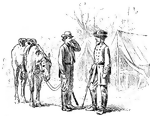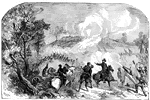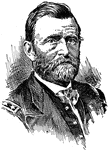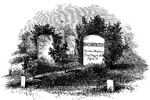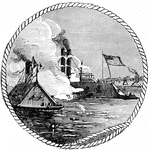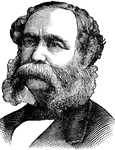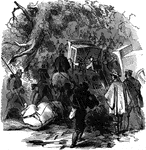
March of General Banks
"Incident in the march of General Banks's Division during a storm in Western Maryland." — Frank Leslie,…

Headquarters of General Butterfield
"Headquarters of General Butterfield, near Harrison's Landing, James River, Va." —Leslie, 1896
General Hospital Exterior
"United States General Hospital, Hilton Head, S. C., exterior. The United States General Hospital at…

General Hospital Interior
"United States General Hospital, Hilton Head, S. C., interior. The United States General Hospital at…
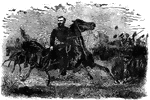
General Sheridan
"Major General Sheridan riding along the lines after the Battle of Fisher's Hills, Va., September 22nd,…

Ironclad Georgia
"Confederate ironclad ram Georgia lying off Fort Jackson, Savannah River, Ga., December 1862."—…

Georgia Campaign
"The campaign in Georgia- Federal troops foraging near Warsaw Sound."— Frank Leslie, 1896
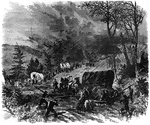
Campaign in Georgia
"The campaign in Georgia. A baggage train crossing the mountains in a storm. General Sherman, after…

War in Georgia
"The war in Georgia- Stevenson, Ala., depot for General Rosecrans's Army. The campaign of General Rosecrans…

War in Georgia
"The war in Georgia. Wagon train passing Resaca at night. Our correspondent wrote: 'No general probably…

Battle of Gettysburg
"Battle of Gettysburg, Cemetery Hill during the attack of the Confederates, Thursday evening, July 2nd,…

Battle of Gettysburg
"Battle of Gettysburg- charge of the Confederates on Cemetery Hill, Thursday evening, July 2nd, 1863.…

Battle of Gettysburg
"Battle of Gettysburg, Thursday evening, July 2nd, 1863, as seen from Rocky Hill, on Meade's left. Our…

Battle of Gettysburg
"The Battle of Gettysburg, Friday morning, July 3rd, 1863. In our illustration may be studied the struggle…

Battle of Gettysburg
"Invasion of Pennsylvania- Battle of Gettysburg, Friday, July 3rd, 1863."— Frank Leslie, 1896
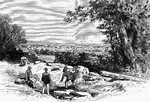
Battlefield of Gettysburg
"The battlefield of Gettysburg- breastworks, Culp's Hill- Gettysburg in the distance."— Frank…
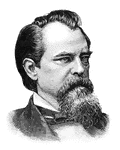
General J. B. Gordon
"General Gordon, born in Upson County, Ga., February 6th, 1832. He was educated at the University of…
Government Buildings - Contraband Camp
"Government buildings for 'Contrabands,' erected at Hilton Head, S. C., in 1862. Among the many singular…
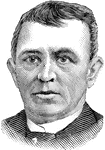
Henry W. Grady
A journalist and orator who helped to reintegrate the former Confederacy into the union after the Civil…

View of Grafton
"View of Grafton, West Virginia, occupied by the Federal Troops, under the command of General McClellan,…

Grafton Occupied by Federal Troops
"View of Grafton, West Virginia, occupied by the Federal Troops, under the command of General McClellan,…

Railroad at Grafton
"View of Grafton, West Virginia, occupied by the Federal Troops, under the command of General McClellan,…
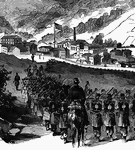
Federal Troops at Grafton, West Virginia
"View of Grafton, West Virginia, occupied by the Federal Troops, under the command of General McClellan,…

Badge of the Grand Army of the Republic
"The Grand Army of the Republic was a patriotic organization in the United States composed of the National…

Badge of the Grand Army of the Republic
"The Grand Army of the Republic was a patriotic organization in the United States composed of the National…

Battle of Grand Coteau
"Battle of Grand Coteau, La., November 3rd, furious attack on the Sixtieth Indiana, Colonel Owen. On…

Battle of Grand Coteau
"The war in Louisiana- Battle of Grand Coteau- capture of the Sixty-seventh Indiana by the Texas Mounted…
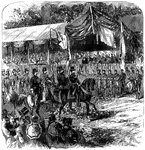
Grand Review
"The Grand Review at Washington, D. C., May 24th, 1865- President Johnson, Lieutenant General Grant…

Grand Skedaddle
"The 'Grand Skedaddle' of the inhabitants from Charleston, S. C., when threatened by an attack from…

Grand Skedaddle - Families with Luggage
"The 'Grand Skedaddle' of the inhabitants from Charleston, S. C., when threatened by an attack from…
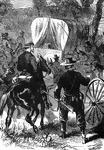
Grand Skedaddle - Detail of Wagons
"The 'Grand Skedaddle' of the inhabitants from Charleston, S. C., when threatened by an attack from…
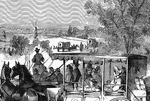
Grand Skedaddle - Horse-drawn Carriage
"The 'Grand Skedaddle' of the inhabitants from Charleston, S. C., when threatened by an attack from…

General Gordon Granger
"General Granger, born in New York, in 1821, died in Santa Fe, N. M., January 10th, 1876, was graduated…
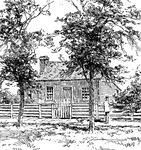
General Ulysses Grant's Birthplace
The house in which General Grant was born in Point Pleasant, Ohio, east of Cincinnati on the Ohio River.

Grant's Campaign
"Grant's Campaign in Virginia. The Battle of Bethesda Church, between Crawford's division, Fifth Corps,…
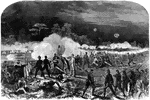
Grant's Campaign
"Grant's Campaign in Virginia. Repulse of Lee's night attack on Smith's Brigade, Hancock's Corps, Friday,…
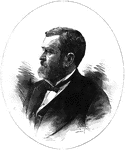
Ulysses Grant
General Grant, eighteenth President of the United States, born at Point Pleasant, Clermont County, Ohio,…
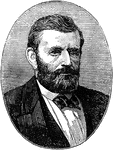
Ulysses S Grant
General Ulysses S. Grant, who alsoserved as the eighteenth president of the United States.

Ulysses S. Grant
Ulysses S. Grant, born Hiram Ulysses Grant (April 27, 1822 – July 23, 1885), was an American general…

Great Bakery
"The Great Bakery for the United States Army at the Capitol, Washington, D. C.- sketched by our special…

Great Falls
"Shelling Confederate cavalry across the Potomac River from the heights of Great Falls, by Major West,…

General Greely
(1844-1935) Explorer and soldier who volunteered in the Civil War and lead an expedition to the Artic.
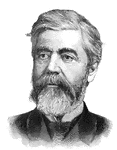
General Walter Q. Gresham
"General Gresham, Secretary of State, born near Lanesville, Harrison county, Ind., March 17th, 1832;…
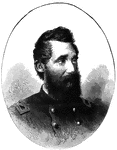
General Benjamin H. Grierson
"General Grierson, born in Pittsburg, Pa., July 8th, 1826."— Frank Leslie, 1896
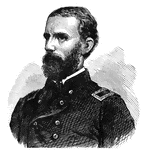
General Cuvier Grover
"General Grover, born in Bethel, Me., July 24th, 1829, died in Atlantic City, N. J., June 6th, 1885,…

Guarding Lancers
"Rush's lancers guarding the roads, the day after the Battle of Antietam, to prevent the passage of…

Gunboat collision
"Desperate engagement, april 24th, 1862, between the United States gunboat "Varuna," Commander Boggs,…
Gunboat engagement
"Engagement between the United States gunboats, commanded by Commodore Davis, and the Confederate Mosquito…

Gunboat of the Mississippi
A gunboat of the Mississippi. Gunboats Essex, Carondelete, Cincinnati, St. Louis, and Benton steamed…

Company H
"Successful charge of Company H, first Massachusetts regiment (Captain Carruth), on a Confederate redan…

Edward Everett Hale
(1822-1909) Minister who wrote The Man Without a Country to encourage patriotism during the Civil War.

